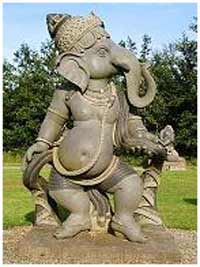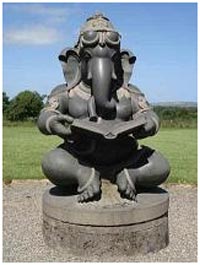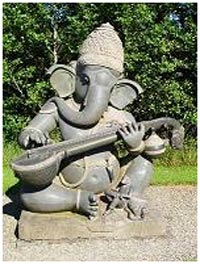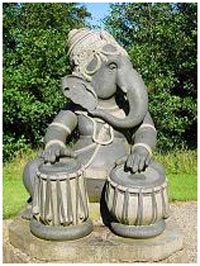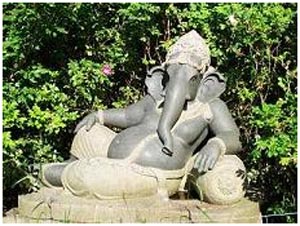IRELAND, September 30, 2015 (India Travelogue by Manohar Rakhe): Manohar V. Rakhe, an NRI from London, visits Victoria’s Way, in a small village called Roundwood in county Wicklow, southeast of Dublin, Ireland. A Maharashtrian by birth who has always worshipped Lord Ganesh, he calls this a pilgrim journey in Ireland. Late last year I had read in one of the Marathi newspapers from India that just south of Dublin, there is a park that houses some huge statues of Lord Ganesh. No further information could be gleaned from the newspaper itself. So with the help of the internet and through telephone conversations with the proprietor of the park and the local bus company in Dublin, I gathered as much information as I could.
There are 9 Ganesh statues in the Park. Apart from one sitting statue of Sri Ganesh, reading a tome, all the others are either dancing or playing a musical instrument. The Victoria’s Way collection of black granite Ganesh (Vinayaka) took about 9 years to design, model and carve. The sculptures range in size from 5ft 6ins to 9ft and weigh between 2 and 5 tonnes. The sculptures were envisioned and sketched in Roundwood in Ireland by Victor Langheld, then modelled by the artist D.V. Murugan in Mahabalipuram (Mamallapuram), Tamil Nadu, India. They were carved in Mahabalipuram by an outstanding sculptor, the stapathi master T. Baskaran.
For more of this interesting travelogue and the story of Victoria’s Way park founder, Victor Langheld
This one in Ireland is different. How? Let me start from the beginning. |
|||||
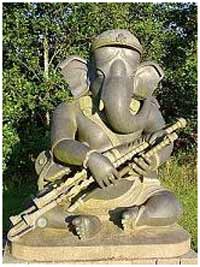 Late last year I had read in one of the Marathi newspapers from India that just south of Dublin, there is a park that houses some huge idols of Lord Ganesh. No further information could be gleaned from the newspaper itself. So with the help of the internet and through telephone conversations with the proprietor of the park and the local bus company in Dublin, I gathered as much information as I could.Early one morning I left London, where I live, for Dublin. Unusually for Dublin, it was cloudy but dry, although quite cold. Southeast of Dublin, in county Wicklow, there is a small village called Roundwood. That was my first destination. There is only one bus a day from Dublin to Roundwood and back. The bus arrived and left Dublin on time. The driver dropped me off at Roundwood. When I mentioned the Park to him, his response was “Never heard of it”. Strange, I thought, as the Park had been in existence for a few years. To call it a park is a bit of a misnomer. It is in fact, a 22 acre field. All that grows there is grass and the trees that the owner, Victor Langheld has planted. Late last year I had read in one of the Marathi newspapers from India that just south of Dublin, there is a park that houses some huge idols of Lord Ganesh. No further information could be gleaned from the newspaper itself. So with the help of the internet and through telephone conversations with the proprietor of the park and the local bus company in Dublin, I gathered as much information as I could.Early one morning I left London, where I live, for Dublin. Unusually for Dublin, it was cloudy but dry, although quite cold. Southeast of Dublin, in county Wicklow, there is a small village called Roundwood. That was my first destination. There is only one bus a day from Dublin to Roundwood and back. The bus arrived and left Dublin on time. The driver dropped me off at Roundwood. When I mentioned the Park to him, his response was “Never heard of it”. Strange, I thought, as the Park had been in existence for a few years. To call it a park is a bit of a misnomer. It is in fact, a 22 acre field. All that grows there is grass and the trees that the owner, Victor Langheld has planted.
In addition to the Ganesh idols, there are idols of Lord Shiva, Durga Devi, and a fasting Buddha, amongst others.
While I was wandering through this field, clicking away with my old-fashioned camera, it was continuing to drizzle and the mercury was dipping gradually. Finally, when my fingers refused to co-operate with my desire to capture images, I retired to the comparative warmth of Victor’s office. We talked for the best part of an hour. What Victor had to tell me was just as fascinating.
Soon afterwards, Victor’s father moved to Ireland and settled there with his family. Victor himself started his primary education in Ireland. By the age of 14, he had decided to go to India, keen to become a sadhu and spend his life in the pursuit of enlightenment. Before he had reached 25, Victor was in India. Thereafter, he spent the next 25 years as a wandering monk in India, learning about Hinduism, Buddhism, Yoga, studying the Vedas and Upanishad. He spent some time at the Arobindo Ashram in Pondicherry. He travelled widely through India, spending time at various ashrams, under the tutelage of many gurus. He also travelled to the Far East.
During his long stay in India, not only did he came to love the country, but his own devotion to Sri Ganesh, arguably the most beloved of the gods, grew. That gave him the idea of starting a Ganesh Park in Ireland. Once the idea took root, it took 20 years for that dream to become reality. Shipping statues weighing a few tons each, does not come cheap. But with tenacity, determination and financial provision made by his father, Victor realized his dream. Currently, he has no plans to import any more idols to Victoria’s Way Sculpture Park.
Indian devotees of Ganesh, make a pilgrimage to 8 shrines of Ganesh, scattered all over Maharashtra state. It takes 2 to 3 days and can be exhausting. From London to Roundwood, Ireland, a similar pilgrimage can be completed in one day. I advocate it as a worthy experience. |
|||||






